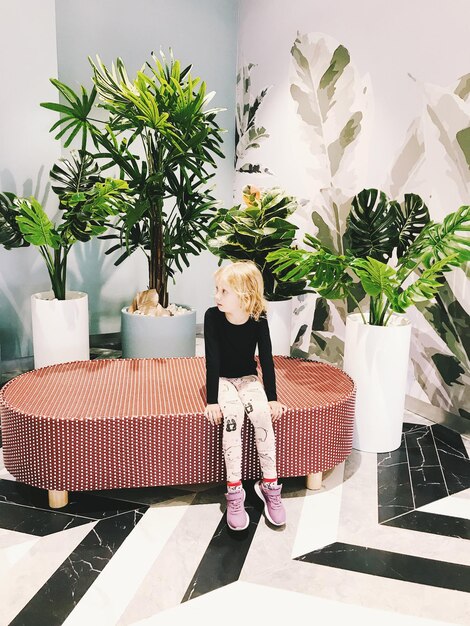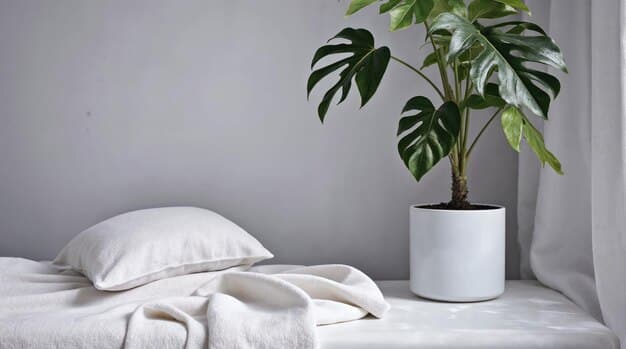Gen Z’s Home Decor: Minimalism & Functionality Unpacked

Gen Z’s home decor preferences emphasize a blend of minimalism and functionality, driven by a desire for practicality, sustainability, and authentic self-expression in their living spaces, reflecting broader societal values and economic realities.
The landscape of home decor is always shifting, reflecting generational values, economic realities, and evolving aesthetic sensibilities. Today, a new generation is leaving its indelible mark on interior design: Gen Z. Their approach to creating personal sanctuaries, often at odds with previous trends, is characterized by a strong lean towards Gen Z’s Home Decor: How Minimalism and Functionality Are Shaping Their Living Spaces, prioritizing practicality, sustainability, and individual expression over ostentatious displays.
The Gen Z Aesthetic: More Than Just a Trend
Gen Z, born roughly between 1997 and 2012, is the first truly digital native generation. Their formative years were shaped by access to vast amounts of information, global connectivity, and a heightened awareness of social and environmental issues. These influences manifest profoundly in their approach to personal spaces, moving beyond mere aesthetics to embrace deeper values.
The aesthetic they gravitate towards is far from a fleeting fad; it’s a reflection of deeper underlying principles. While Instagram-worthy vignettes might still hold appeal, the core motivation for Gen Z in decorating their homes stems from a desire for authenticity and a rejection of consumerist excesses. This isn’t about perfectly manicured spaces, but rather comfortable, lived-in environments that truly serve their needs and reflect who they are.
Conscious Consumption and Sustainability
A driving force behind many of Gen Z’s decor choices is a profound commitment to sustainability. Unlike generations before them, they have grown up with alarming news about climate change and environmental degradation. This awareness translates directly into their purchasing habits, including home goods.
- Second-Hand & Vintage Finds: Gen Z frequently opts for thrift stores, antique shops, and online marketplaces to find unique, pre-loved items, reducing waste and often saving money.
- Sustainable Materials: There’s a preference for items made from natural, recycled, or ethically sourced materials such as bamboo, reclaimed wood, organic cotton, and recycled glass.
- Longevity Over Trends: Rather than constantly updating their decor to chase fleeting trends, Gen Z invests in durable, timeless pieces that can withstand years of use, reducing the cycle of consumption.
This conscious consumption isn’t merely about environmental impact; it also taps into a desire for individuality. A vintage dresser found at a flea market tells a story and offers a unique character that mass-produced furniture often lacks. This personal touch is highly valued, distinguishing their spaces from the homogeneous showrooms often seen in traditional retail.
The emphasis on durability and timelessness aligns perfectly with minimalist principles. Fewer, higher-quality items mean less clutter and less waste. This intentionality in purchasing decisions speaks volumes about their priorities, moving beyond mere appearances to consider the entire lifecycle of an object within their home.
In essence, Gen Z’s approach to home decor is a microcosm of their broader worldview: informed, conscientious, and driven by a desire for positive impact, even in the smallest details of their living environments.
Minimalism: Decluttering for Clarity and Calm
Minimalism isn’t a new concept, but Gen Z has reinterpreted it, moving it beyond stark, unlived-in spaces to something more inviting and functional. For many in this generation, minimalism is less about rigid asceticism and more about intentional living, reducing visual noise to foster mental clarity and a sense of calm. It’s a pragmatic response to an increasingly chaotic world, both online and off.
The core of minimalist decor for Gen Z revolves around decluttering. This isn’t just about throwing things away; it’s about making deliberate choices regarding what enters their living space and what truly serves a purpose. Every item earns its place, contributing either to functionality or aesthetic appeal without overwhelming the senses.
The Power of Less: A Practical Approach
In smaller living spaces, which are often the reality for many young adults, minimalism becomes a necessity rather than just a choice. Gen Z often occupies apartments, dorm rooms, or shared living arrangements where every square foot counts. Minimalism helps maximize space and reduce visual clutter, making these smaller areas feel larger and more open.
- Multi-functional Furniture: Pieces like sofa beds, storage ottomans, and desks that fold away are highly prized for their ability to serve multiple purposes in limited space.
- Clean Lines and Neutral Palettes: A preference for simple designs, uncluttered surfaces, and a muted color scheme (whites, grays, beiges, muted greens) creates a serene backdrop that can be easily personalized with textures and subtle accents.
- Concealed Storage: Built-in storage, hidden compartments, and smart storage solutions are essential for keeping belongings out of sight, maintaining the clean aesthetic.
The appeal of a neutral palette also extends to practicality. These colors are timeless, easy to match, and offer a sense of calm and spaciousness that can be a welcome respite from the constant bombardment of digital information. The deliberate choice of each item ensures that their spaces are not just visually appealing, but also highly organized and conducive to focus, whether for work or relaxation.
Ultimately, Gen Z embraces minimalism as a tool for a more intentional and less stressful life. It’s about freedom from excessive possessions and the mental burden they can impose, allowing for greater focus on experiences, personal growth, and well-being. This functional minimalism reflects a desire to control their environment in a world that often feels beyond their control.
Functionality Reigns Supreme: Designed for Daily Life
For Gen Z, a home is not just a place to live; it’s a dynamic hub designed to support a multifaceted lifestyle that often blends work, study, social connection, and personal well-being. This generation values practicality above all, meaning every piece of furniture and decor item must justify its existence through its utility. Beauty is important, but it rarely comes at the expense of genuine usefulness.
The concept of “form follows function” is deeply ingrained in Gen Z’s decorating philosophy. They seek out pieces that optimize their daily routines, solve common living challenges, and enhance their overall quality of life. This pragmatic approach is particularly evident given their often limited budgets and the compact nature of urban living spaces.
Creating Dynamic and Adaptable Spaces
With an emphasis on versatility, Gen Z designs their homes to be adaptable to various activities. A living room might double as a home office during the day, a gym in the evening, and a social gathering spot on weekends. This demand for flexibility drives choices in furniture and layout.
- Modular Furniture: Sectional sofas that can be reconfigured, shelving units that can be expanded or relocated, and tables with adjustable heights are highly valued.
- Ergonomic Solutions: Given the prevalence of remote work and online learning, ergonomic chairs, standing desks, and proper lighting are invested in to support health and productivity.
- Smart Home Integration: While not purely decor, smart devices that control lighting, temperature, and entertainment enhance functionality and are seamlessly integrated into their living environment.
Beyond individual items, the overall layout of Gen Z homes often reflects this functional imperative. Open-plan living areas are preferred for their flexibility, allowing spaces to flow seamlessly from one purpose to another. Each zone, whether for dining, working, or relaxing, is clearly defined but remains interconnected, fostering a sense of spaciousness and versatility.
The drive for functionality also extends to simplifying routines. Easy-to-clean surfaces, low-maintenance plants, and durable materials reduce the time spent on upkeep, freeing up time for other pursuits. This deliberate focus on efficiency ensures that their living spaces work for them, rather than becoming a source of added stress or chores. The result is a home that truly supports their busy, adaptable lives.

Authenticity and Self-Expression: Beyond Trends
While minimalism and functionality serve as guiding principles, Gen Z’s home decor is far from sterile. In fact, it often serves as a vibrant canvas for authenticity and self-expression. Unlike previous generations who might have felt pressure to conform to aspirational aesthetics or follow rigid decor rules, Gen Z values originality and showcasing their true selves.
This generation has grown up with social media platforms that celebrate individuality and personal narratives. Their homes are an extension of this digital self-presentation, a physical manifestation of their identity, passions, and values. The goal isn’t to impress others with expensive possessions but to create a space that feels uniquely “theirs,” comfortable, and genuinely reflective of who they are.
Personal Storytelling Through Decor
The decor items chosen by Gen Z are often curated to tell a personal story. This emphasis on narrative over pure aesthetics leads to eclectic collections that blend high-end pieces (if budget allows) with thrift store finds, handmade items, and sentimental objects. Every element contributes to a personal micro-narrative within their living space.
- Unique and Sentimental Objects: Rather than generic mass-produced art, Gen Z often displays items with personal meaning, such as concert posters, travel souvenirs, or artwork created by friends.
- DIY and Upcycling: There’s a strong inclination towards do-it-yourself projects and upcycling old furniture, adding a personal touch and a sense of accomplishment while promoting sustainability.
- Curated Collections: Books, records, plants, or specific decor elements are not just decorative but often reflect genuine hobbies and interests, turning spaces into personal galleries.
The result is a look that is often eclectic yet cohesive, bound together not by matching styles but by personal meaning. Imperfections are embraced as part of the charm, and a lived-in feel is preferred over a showroom pristine appearance. This approach moves away from the “perfect home” ideal towards one that is more organic, evolving, and truly reflective of the occupant’s journey.
This focus on authenticity also extends to what is chosen to be visibly displayed. Art, music, and literature are often central themes, reflecting Gen Z’s appreciation for culture and personal development. Their spaces become reflections of their inner worlds, fostering environments that encourage creativity, reflection, and comfortable self-expression.
Technology Integration: Smart Homes, Seamless Living
As digital natives, Gen Z’s relationship with technology is fundamentally different from previous generations. It’s not just a tool; it’s an extension of their daily lives, woven seamlessly into their social interactions, education, work, and entertainment. This inherent comfort with technology naturally extends to their home environments, where smart devices and integrated systems play a significant role in enhancing functionality, convenience, and even the aesthetic appeal of their living spaces.
For Gen Z, a truly functional home often means a smart home. This doesn’t necessarily imply futuristic, voice-controlled mansions, but rather the strategic adoption of accessible smart technologies that simplify everyday tasks and improve comfort. From smart lighting to streaming devices, technology is leveraged to create a more efficient and responsive living experience.
Enhancing Comfort and Efficiency
The practical benefits of smart home technology appeal directly to Gen Z’s desire for functionality and efficiency. These devices allow for greater control over their environment, often through intuitive apps or voice commands, streamlining various aspects of home management.
- Smart Lighting Systems: Beyond mere convenience, smart lights can adjust color temperature to support circadian rhythms, set moods for different activities (study, relaxation), and even conserve energy.
- Voice Assistants and Hubs: Devices like Amazon Echo or Google Home act as central command centers, managing schedules, playing music, controlling other smart devices, and providing information on demand.
- Entertainment Integration: Seamless streaming setups, high-quality audio systems, and gaming setups are often central to Gen Z’s living rooms, designed for both personal enjoyment and social gatherings.
The integration of technology often aligns with the minimalist aesthetic. Many smart devices are designed with sleek, unobtrusive forms that blend into contemporary decor. Wires are hidden, devices are compact, and control panels are often replaced by smartphone apps, reducing visual clutter and maintaining clean lines.
Beyond convenience, smart home technology also addresses Gen Z’s affinity for data and personalization. Many devices offer insights into energy consumption or usage patterns, empowering them to make more informed and sustainable choices about their home environment. This synergy between technology, functionality, and minimalism creates living spaces that are not only aesthetically pleasing but also highly efficient and responsive to their inhabitants’ needs.
The Evolution of “Home”: More Than Just Four Walls
The concept of “home” for Gen Z extends far beyond its physical boundaries. Influenced by global connectivity, fluid work arrangements, and a heightened awareness of mental well-being, their living spaces are viewed as dynamic ecosystems that support a holistic lifestyle. This broadening definition of home impacts every decor choice, emphasizing adaptability, comfort, and a seamless integration of indoor and outdoor environments.
For a generation that values experiences over possessions, the home becomes a launchpad for those experiences, a sanctuary for recharge, and a flexible hub for productivity and creativity. It’s not just a place to sleep; it’s a personal retreat that must meet diverse needs throughout the day and night.
Cultivating Well-being and Connection
Gen Z understands the intrinsic link between their physical environment and their mental and emotional health. Their decor choices often reflect a deliberate effort to create spaces that foster calm, reduce stress, and promote a sense of well-being. This focus is particularly relevant in an era marked by digital overload and increased awareness of mental health challenges.
- Biophilic Design Elements: An abundance of indoor plants (even low-maintenance varieties), natural light, and organic textures are integrated to bring the calming effects of nature indoors.
- Dedicated Wellness Zones: Spaces might include dedicated areas for meditation, yoga, or reading, designed to encourage specific well-being practices.
- Comfort and Texture: Soft furnishings, cozy textiles, and comfortable seating are prioritized to create inviting and relaxing atmospheres conducive to unwinding and connecting with others.
Furthermore, the Gen Z home is often designed with social connection in mind. While highly digitally connected, they also value meaningful in-person interactions. Flexible seating arrangements, comfortable gathering areas, and easily adaptable spaces for entertaining reflect this desire to host friends and family in a casual, inviting environment.
The blurring of lines between work and life, especially with the rise of remote work, means that home must also serve as a professional space. Ergonomics, reliable internet, and designated work zones are crucial, integrated in a way that doesn’t compromise the comfort or aesthetic of their personal sanctuary. Thus, the Gen Z home truly becomes a multi-functional, adaptive organism, designed for a life that often defies traditional boundaries.
Future-Proofing: Longevity and Adaptability in Decor
Gen Z’s approach to home decor is deeply rooted in a future-oriented mindset. They are a generation acutely aware of rapid change, environmental concerns, and economic instability. This awareness translates into a desire for homes that are not only personally reflective but also resilient, adaptable, and relevant for years to come. Their decor choices are a form of investment, favoring items that can withstand shifting trends and evolving life stages.
The concept of “future-proofing” their living spaces goes beyond merely choosing durable materials. It involves a strategic selection of pieces and layouts that can be easily modified, repurposed, or upgraded without requiring complete overhauls. This approach stands in contrast to past consumer cycles built on disposable trends, reflecting a more mature and sustainable outlook.
Design That Grows and Adapts
For Gen Z, a home is not a static entity but a dynamic space that should evolve with them. As they navigate career changes, relationship shifts, and potential moves, their decor needs to be flexible enough to accommodate these transitions gracefully. This means investing in foundational pieces that offer enduring value and versatility.
- Modular Design: Sectional sofas, customizable shelving systems, and furniture with interchangeable components offer easy reconfiguration as needs change.
- Neutral Foundations: Large, expensive items like sofas, beds, or primary wall colors are often kept neutral, providing a versatile backdrop that can be refreshed with less expensive, trendy accents.
- Timeless Craftsmanship: There’s an appreciation for well-made furniture with classic designs, even if it means a higher initial investment. These pieces are seen as heirlooms that can endure for decades.
The emphasis on adaptability also extends to technology. While Gen Z embraces smart home innovations, they often look for systems that are interoperable and easily updatable, avoiding proprietary technologies that might become obsolete quickly. This ensures that their integrated homes can grow alongside technological advancements.
In essence, Gen Z is redefining what durability means in home decor. It’s not just about physical sturdiness, but about intrinsic flexibility and evergreen appeal. By prioritizing items that offer both practical longevity and aesthetic adaptability, they are crafting living spaces that are truly future-proof, reflecting a deep-seated commitment to intentionality, sustainability, and personal resilience in an ever-changing world.

| Key Aspect | Brief Description |
|---|---|
| 🌱 Sustainability Focus | Prioritizes ethical sourcing, second-hand, and durable materials, reflecting environmental consciousness. |
| 📏 Functional Minimalism | Embraces clean lines and multi-purpose items, valuing practicality and decluttered spaces. |
| 🎨 Authentic Self-Expression | Decorates with unique, sentimental pieces that tell a personal story, avoiding generic trends. |
| 🌐 Tech Integration | Seamlessly incorporates smart home devices for efficiency, comfort, and entertainment, enhancing daily life. |
Frequently Asked Questions About Gen Z Home Decor
Minimalism appeals to Gen Z due to its emphasis on intentionality, decluttering, and a desire for mental clarity in an often overwhelming world. It also aligns with their appreciation for practical, multi-functional spaces, especially given common urban living constraints and a preference for experiences over excessive material possessions.
Sustainability is a core value for Gen Z, leading them to prioritize second-hand items, furniture made from recycled or ethically sourced materials, and products designed for longevity. This reduces environmental impact and allows for unique, personalized spaces that resist fast-fashion decor trends, reflecting a conscious consumption mindset.
Functionality for Gen Z means that every item in their home serves a practical purpose or enhances their daily life. This includes multi-functional furniture, ergonomic solutions for work and study, and seamless integration of smart home technology. Their spaces are designed to be adaptable and efficient, supporting their diverse activities and lifestyles.
While minimalist, Gen Z homes are far from sterile. They express individuality through curated collections, sentimental objects, DIY projects, and personal artwork. The minimalist backdrop allows these unique elements to stand out, creating spaces that are authentic, inviting, and deeply reflective of the occupant’s personality and interests.
Technology is crucial for Gen Z’s home decor, not just as gadgets but as integral components of their functional living spaces. Smart lighting, voice assistants, and seamless entertainment systems are often integrated to enhance comfort, efficiency, and convenience, reflecting their native digital fluency and desire for a responsive, modern home environment.
Conclusion
Gen Z’s approach to home decor is demonstrably shifting the paradigm of interior design. Their preference for minimalism and functionality is not merely a stylistic choice but a deeply ingrained philosophy reflecting their values: sustainability, authenticity, and adaptability. These young adults are creating spaces that are not only aesthetically pleasing but also highly practical, environmentally conscious, and profoundly personal. By embracing fewer, more meaningful possessions and leveraging technology to enhance daily life, Gen Z is crafting homes that are resilient, reflective of their identities, and inherently future-proof, shaping a new standard for purposeful living.





